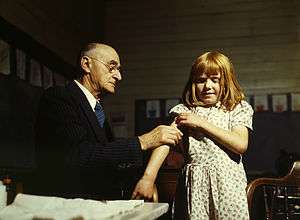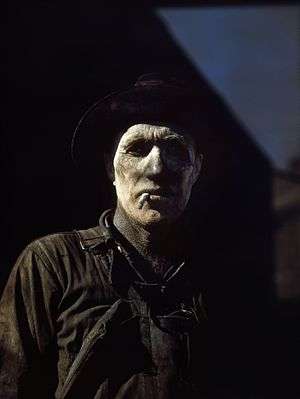John Vachon
| John Vachon | |
|---|---|
 Vachon in 1942 | |
| Born |
John Felix Vachon[1] May 19, 1914 Saint Paul, Minnesota |
| Died |
April 20, 1975 (aged 60) New York City, New York |
| Nationality | American |
| Known for | Photography |
John Felix Vachon (May 19, 1914 – April 20, 1975) was an American photographer. He worked as a filing clerk for the Farm Security Administration before Roy Stryker recruited him to join a small group of photographers, including Esther Bubley, Marjory Collins, Mary Post Wolcott, Jack Delano, Arthur Rothstein, Walker Evans, Russell Lee, Gordon Parks, Charlotte Brooks, Carl Mydans, Dorothea Lange and Ben Shahn, who were employed to publicize the conditions of the rural poor in America.
Family and education
Vachon was born in Saint Paul, Minnesota, the son of Ann Marie (O'Hara) and Harry Parnell Vachon.[2] He graduated from Cretin High School (now Cretin-Derham Hall High School). He received a bachelor's degree in 1934 from the University of St. Thomas in Saint Paul, then named the College of St. Thomas. In about 1938 he married Millicent Leeper who was known as Penny. She died in 1960. Vachon married Françoise Fourestier in 1961. Vachon served in the United States Army in 1945.[3]
Vachon's daughter, Christine Vachon, is a noted independent film producer.
Later years
John Vachon's first job at the Farm Security Administration carried the title "assistant messenger." He was twenty-one, and had come to Washington from his native Minnesota to attend The Catholic University of America. Vachon had no intention of becoming a photographer when he took the position in 1936, but as his responsibilities increased for maintaining the FSA photographic file, his interest in photography grew.[4]
By 1937 Vachon had looked enough to want to make photographs himself, and with advice from Ben Shahn he tried out a Leica in and around Washington. His weekend photographs of "everything in the Potomac River valley" were clearly the work of a beginner, but Stryker lent him equipment and encouraged him to keep at it. Vachon received help as well from Walker Evans, who insisted that he master the view camera, and Arthur Rothstein, who took him along on a photographic assignment to the mountains of Virginia. In October and November 1938, Vachon traveled to Nebraska on his first extensive solo trip. He photographed agricultural programs on behalf of the FSA's regional office and pursued an extra assignment from Stryker: the city of Omaha.[4]
The hallmark of this style of photography is the portrayal of people and places encountered on the street, unembellished by the beautifying contrivances used by calendar and public relations photographers.[4]
He was a photographer for the Office of War Information in Washington, D.C. from 1942 to 1943, and then staff photographer for Standard Oil Company of New Jersey between 1943 and 1944. After serving in the army in 1944–45, in 1947 Vachon joined the Photo League, where he wrote book reviews for Photo Notes and participated in many exhibition.[5] Between 1945 and 1947 he photographed New Jersey and Venezuela for Standard, and Poland for the United Nations Relief and Rehabilitation Administration.[3] Vachon became a staff photographer for Life magazine, where he worked between 1947 and 1949, and for over twenty five years beginning in 1947 at Look magazine. In 1953 Vachon took the first pictures of Marilyn Monroe and Joe DiMaggio when Monroe cured a sprained ankle near Banff, Canada. When Look closed in 1971 he became a freelance photographer. In 1973, he won a Guggenheim fellowship.[5] In 1975 he was a visiting professor at the Minneapolis Institute of Arts.[3]
He died in 1975 in New York at age 60.[3]
Samples of photography
|
Notes
- ↑
- ↑
- 1 2 3 4 Vachon, John. Prepared by Connie L. Cartledge (2006). "John Vachon: A Register of His Papers in the Library of Congress". Manuscript Division, Library of Congress. Retrieved 2007-10-10.
- 1 2 3 "Omaha, in Photographs from the FSA and OWI, Documenting America, Chapter 2". The Library of Congress, from Fleischhauer, Carl and Brannan, Beverly (eds.). Documenting America, 1935-1943. Berkeley: University of California Press, 1988. 15 December 1998. Retrieved 2007-10-20.
- 1 2 John Vachon Biography at The Jewish Museum
External links
| Wikimedia Commons has media related to John Vachon. |
- Vachon, John. Prepared by Connie L. Cartledge (2006). "John Vachon: A Register of His Papers in the Library of Congress". Manuscript Division, Library of Congress. Retrieved 2007-10-10.
- John Vachon in MNopedia, the Minnesota Encyclopedia
- Nationally-known research project to track down descendants of people photographed by John Vachon and other Farm Security Administration photographers
- Richard Doud (1964). "Oral history interview with John Vachon, 1964 Apr. 28". Archives of American Art. Retrieved 2011-01-26.
- Post-World War II Photos of Poland by John Vachon from the JDC Archives.
.jpg)

.jpg)

